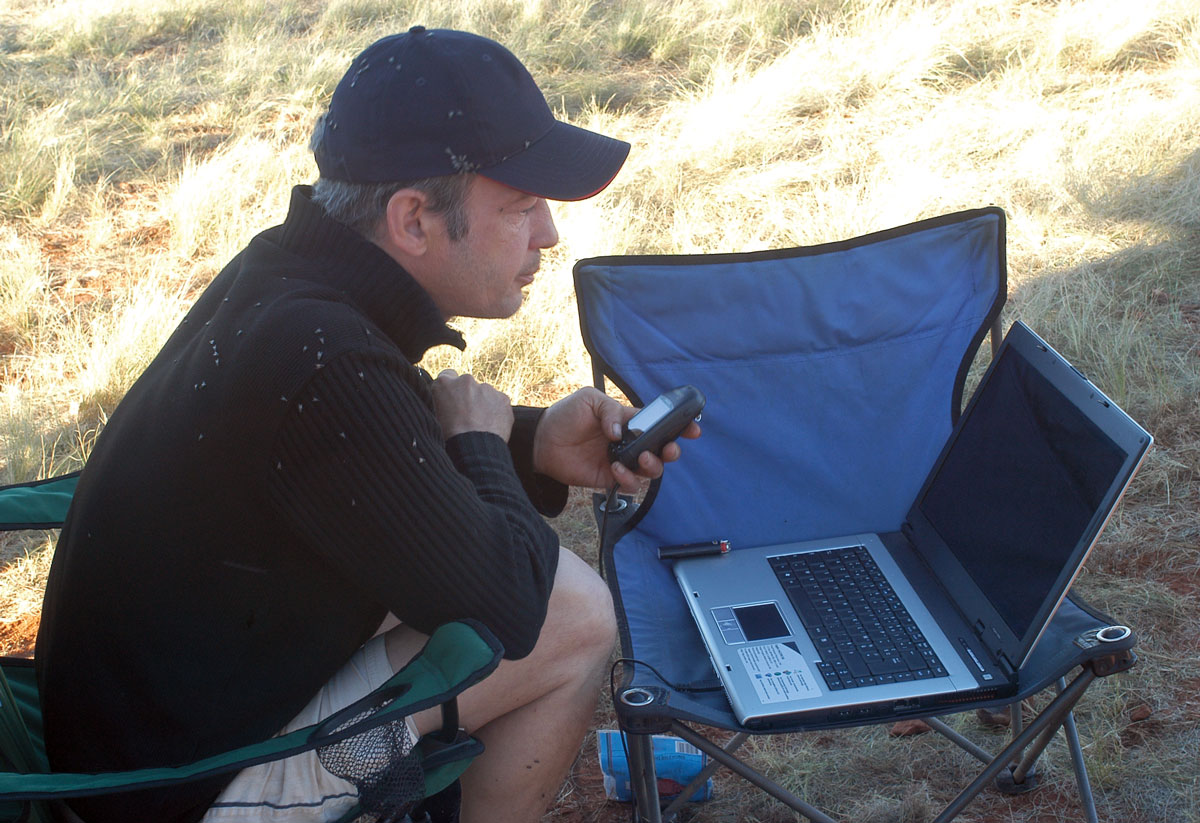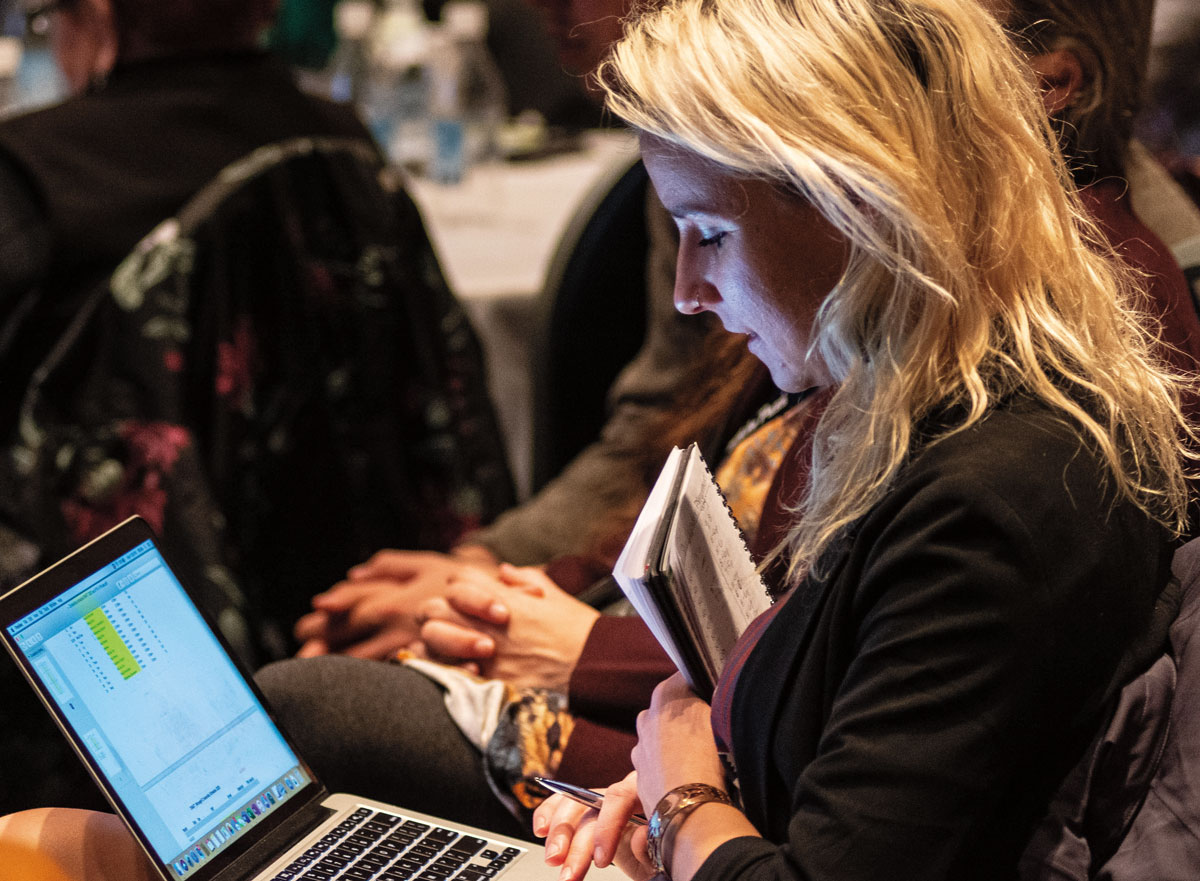
s the coronavirus pandemic persists, going virtual takes on a deeper meaning for larger-scale events where people have traditionally gathered in person for training, education, and networking. Many Alaska organizations are converting their conventions, conferences, and other meetings to online or hybrid options that are safe for attendees.
Take, for example, the Anchorage Economic Development Corporation (AEDC) 3-Year Outlook Virtual Luncheon, which took place in August. AEDC’s decision to hold the event online was relatively easy to make, especially given that the health and safety of its team, vendors, sponsors, and audience was at stake. “We surveyed our sponsors and members back in May to check in with them and also analyze their level of comfort with an in-person event,” Development Director Tara Nokelby says. “It was fairly clear at that time that we would be pivoting to a virtual event and, given the current climate, we’re extremely happy we made that call.”
Of course, turning an in-person event into a virtual meeting comes with significant challenges. AEDC wanted to give its audience the same level of production that it provides at in-person luncheons—just through their computer or TV screens. “What was important to me was that I presented them something exciting rather than a run-of-the-mill webinar,” Nokelby says.
Initial planning for the remote luncheon, Nokelby says, involved formulating an audience experience and deciding what that experience would look like. Once the vision was locked in, AEDC began seeking out vendors and working out the logistics. “A great platform with both host and user accessibility is crucial, so audio and visual always needs to be on-point whether it is in-person or virtual,” she says. “We were lucky to team up with Alaska Public Media and GCI as our technology sponsor for the 3-Year Outlook Virtual Luncheon, so we knew we were in good hands.”
Indeed, Nokelby was “blown away” by the attendance numbers, with more than 1,000 people tuning into the luncheon. And the registrants were able to submit questions during the event, which can be difficult to accomplish with a large in-person meeting. The virtual Q&A afforded the audience an opportunity to engage with the speakers and data comfortably and with minimal moderation. “Just because an event is virtual doesn’t mean we can’t still give a great guest/attendee experience,” she says.
When pivoting an event away from the original vision, it can be a little scary, Nokelby says. She explains: “I was worried that no one would buy tickets or that people would purchase one ticket for multiple people, but we did not see that with our event. I think a lot of it does have to do with the fact that most people are still working from home. But even those who did plan on showing up in a boardroom purchased company tickets [ten tickets], and that was really great to see the support we are getting from our audience, both investors and non-investors.”
The Alaska Chiropractic Society (ACS) also elected to go virtual for its state convention this year. So what made ACS choose to stage a virtual state convention instead of canceling it due to COVID-19? There were two key factors: uncertainty and necessity.
In “normal” times, ACS hosts a biennial convention in October for licensed chiropractors and their staff to provide the continuing education (CE) and training they need to meet state licensing and certification requirements. The uncertainty of the COVID-19 mandates/restrictions surrounding event gatherings in the fall kept ACS from moving forward with planning an in-person event, according to Chief Operating Officer Sheri Ryan. However, the organization still had an obligation to meet the required CE needs of the chiropractic physicians in Alaska.
In addition, Ryan says, many ACS members expressed a number of concerns. They were worried about their ability to attend the fall event due to local travel quarantine restrictions upon their return, the financial considerations incurred due to reduction in hours or closures they had experienced, and the slowdown in the economy in their area even after their businesses had fully reopened. So ACS opted to launch its convention as an on-demand, virtual option in mid-June. “The use of virtual events allowed us to provide the continuing education and training needed without travel or quarantine considerations for our attendees or speakers at a price point that was affordable for all,” Ryan says.
Gilles Paire | iStock

Gilles Paire | iStock
Logistically, a number of steps had to take place to make the virtual convention feasible for ACS members. For instance, the Board of Chiropractic Examiners voted in mid-May to modify CE requirements for the current license renewal period, allowing all credits to be earned online. Then it was a matter of finding the appropriate technology to facilitate the convention. Ryan explains: “I investigated several virtual event platforms where we could host our event live, on-demand, or a hybrid version. Because we needed to pivot quickly and launch our virtual convention, I decided on a company called SIDECAR, a chiropractic business development and training firm that provided me with the best of both worlds: the tech side platform and the content speakers.”
Ryan needed a company with a library of high-quality, chiropractic-specific content that she could use as the foundation of her educational platform. She also needed the ability to add pieces required to meet specific CE approval requirements set by the Alaska Board of Chiropractic Examiners. “From the tech side, I wanted a platform that was intuitive to use, available across multiple devices by the user, and included time-based and attentiveness tracking,” she says. “The SIDECAR training platform is built on the LightSpeed VT system, which met all my needs.”
Ultimately, Ryan chose to offer a fully on-demand option as opposed to a live event. This lets the primary attendees—chiropractic physicians across the state—participate at their own pace, on their own schedule. Ryan presented the content in a variety of formats, including presentation slides, demonstration videos, and lectures, in an attempt to tailor the experience to the many different learning styles. “We provided informational training videos in the training center demonstrating how to use the module system, how to read the dashboard, print out completion certificates, et cetera, and organized the content so that attendees had a clear sense of how and what to do within the platform,” she says.
While the CE component of ACS’ virtual state convention is available entirely on-demand, there is also a “live” component in October. Registration has been slow since the event launched in mid-June, but that’s not surprising; it’s summer in Alaska. “We anticipate registration will pick up greatly as our regularly scheduled October convention time nears and chiropractors gear up to complete the requirements for their license renewal,” Ryan says.
The virtual state convention has so far been well-received. The doctors who have started their training report a great appreciation for the ability to complete their CE at their convenience and in smaller “chunks,” as opposed to sitting in a lecture for two to four hours, Ryan says.
Ryan’s favorite comments are from attendees who completed part of their education while on an exercise bike and another portion on the deck enjoying the Alaska evening sun. “If attendees are enjoying themselves while experiencing the presentations and having positive engagement with the platform, I count that as a huge win,” she says. “My only concern is how will I get them back into a hotel ballroom for a lecture again after they have experienced this type of freedom.”
The Alaska Travel Industry Association’s (ATIA) annual convention is one of the most valued benefits of being an ATIA business or partner organization. So as the ATIA watched other meetings and events start to be postponed or cancelled due to COVID-19, it reached out to its members via an online survey asking for input on the annual tourism industry convention and trade show that it normally hosts in the fall.
Survey respondents had mixed feelings, according to ATIA President and CEO Sarah Leonard. “While our members ideally wanted to gather in person, the uncertainty of the status of the coronavirus challenged many of our members who would have traveled to Anchorage and/or participated in the convention and trade show,” she explains. “At the same time, our membership provided us with their feedback that they wanted to gather in some way in October. With this information and ATIA Board of Director guidance, we decided to move our in-person Anchorage event to 2021 and are hosting a virtual convention week this October 5-9.
To make the online convention happen, the ATIA team began researching event and meeting platforms—including cost, logistics, and staff expertise—that could support a virtual event. ATIA has been hosting online meetings and presentations since earlier this year as a way to continue to provide information to its members and the visitor industry at large. From that experience, the association knew it needed to think through an easy and efficient way for its members to register, participate, and network using an online system. “We also reviewed what media works best with various connectivity in communities throughout the state and are sensitive to ‘webinar’ burnout,” Leonard says. “ATIA’s goal is to provide a virtual convention week for our industry to be able to gather as well as choose from various high value presentations and meetings.”
ATIA relies on Zoom to host webinars and meetings. And while attendees may not be able to physically rub elbows during the online event, they do have opportunities to network with one another. Zoom’s platform allows participants to use a chat function to interact online and raise their emoji hands for questions. ATIA also invites attendees to submit questions prior to convention webinars and presentations. The group even thought to include time for attendees to network at a virtual social hour.
Fabio Principe | iStock

Fabio Principe | iStock
Boneman | Twenty20

Boneman | Twenty20
As one of the largest event organizers in the state, WTC Anchorage has been conducting meetings throughout Alaska—including in Fairbanks, Juneau, and Kodiak—for more than thirty years. The events include six major conferences each year as well as the Tech Forward Alaska Luncheon and Alaska Infrastructure Development Luncheon. WTC Anchorage also holds three country-focused conferences for places like China, Japan, and Korea, along with receptions for visiting delegations and weekly member lunches.
But this year, COVID-19 caused a temporary disruption for the organization, whose membership consists of more than one hundred entities involved with international trade and business. For four months, WTC Anchorage didn’t host any events in any format. But at the end of June, the organization decided to hold in-person events again based on feedback from its members and the community. WTC Anchorage resumed meetings slowly and carefully in July, starting with its popular luncheon series: Meet and Brief. The hourlong event accommodated about two dozen people and sold out almost immediately. “I could have sold a lot more seats, two or three times that,” Executive Director Greg Wolf says. “Generally, we can have up to fifty people, but because of social distancing requirements we are doing twenty to twenty-five.
“It was very gratifying that when we did our first one a week ago [on July 15], I stood up and announced that we are very happy to be back and got a standing ovation,” Wolf says. “The people were glad we were back—and they were glad to be back meeting in person.”
Attendees followed recommended safety precautions, but they were also networking and exchanging business cards as usual. “As best we could, we replicated what we normally do,” Wolf says.
In mid-August, WTC Anchorage was making provisions for a virtual option for many of its events. “Our goal now—and beyond these times of COVID—is to offer a dual platform for our members and guests to participate in our programs in person [health guidelines permitting] or virtually,” he says. “In other words, people will have a choice in how they participate.”
Organizations in Alaska have gained unique insights from staging conventions and other meetings during the coronavirus pandemic. For instance, Wolf feels it’s imperative for WTC Anchorage—and other businesses—to determine a way to open safely. His personal belief is that businesses cannot wait for a vaccine to be developed to resume operations, and that’s why he was anxious to get back to in-person weekly luncheons. He explains: “We couldn’t see our businesses standing still month after month. The prospect of everything shut down by choice didn’t seem very realistic to us. I think smart people can figure out ways of opening and still doing so in a reasonably safe way; otherwise, there won’t be an economy or businesses to go back to.”
In addition, COVID-19 has underscored the need for WTC Anchorage to hold traditional, in-person events. There are some aspects of business that can occur online in a virtual atmosphere, but a lot of business needs to happen face to face, Wolf says. “Everyone’s trying to adapt the best they can and as fast as they can,” he says. “Our whole livelihood depends on people meeting in person.”
Frank Flavin | Alaska Travel Industry Association

Frank Flavin | Alaska Travel Industry Association
World Trade Center Anchorage
Ryan says ACS’ biennial conventions provide networking opportunities for its doctors and their staff to learn from each other’s real world experiences; engagement with exhibitors to learn about new products and services to assist them in their profession and in their businesses; and an opportunity to just have fun with their peers in a social setting. However, the virtual event is only addressing one component of the state convention—the CE piece for the chiropractic physician. She says: “Our attendees come to our event for more than just continuing education and training; they come for the camaraderie, to catch up with colleagues, to see old friends and make new ones, and to make connections face-to-face. It’s because of this, I know I’ll get them back in the classroom together.”
Ryan says her perception of how to hold an event has shifted. She plans to blend virtual and in-person events in the future to give attendees the best of both worlds. “Lemons, hard times, challenges—however you want to frame it—we’re in it together,” she says. “We wish we were all getting together. But we know better days are ahead.”
As for Nokelby, she feels the decision to conduct a virtual event is situational. “When it comes down to it, if you are unsure whether to host the event and anyone’s health is at stake, push it back or cancel,” she says. “And if you can postpone to support your vendors, do it, because if we don’t support our vendors now, they may not be around next year when we’re (hopefully) back in-person. Of course, some events, like ours, are time-sensitive and cannot be postponed.”
Leonard says it’s been interesting to see how tourism industry businesses and partners have easily adapted to ATIA’s virtual gatherings and convention. “This way of communicating and providing information has quickly become the new normal, at least for today,” she says. ![]()